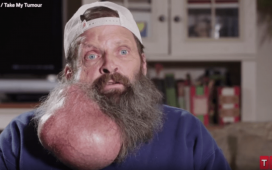You may or may not have caught Joe Wright’s 2011 thriller Hanna. If not, we’ll give you a quick recap. Saoirse Ronan is a feral young woman living in the Bavarian forest with a former secret-ops agent played by Eric Bana. When she was a baby, he saved her from extermination — the kid was part of a government-sponsored experiment, genetic superiority, human weapons, yadda yadda yadda. A C.I.A. operative, i.e. Cate Blanchett as an obsessive-compulsive sociopath, is determined to hunt them down and kill them. Tom Hollander also shows up as a fey assassin of sorts who hangs out with a pair of skinheads. Every actor talks in an accent that is not their own. There are close-ups of bloody teeth-flossing; a few Bourne-style fight sequences involving Ronan and Bana, respectively; an incredibly well-edited gunfight in a hotel room; and more references to Grimm fairy tales than is legal in most states. Trust us when we tell you that it’s even more batshit then it sounds.
40 Most Anticipated TV Shows of 2019
The good news is that anyone who tunes in to Amazon Prime’s Hanna, the eight-episode series that riffs on and builds upon this story (and premieres on March 22nd), doesn’t need to have seen the movie to immediately get the picture. Created by the film’s co-writer David Farr, it spends its first two episodes setting the stage, recasting the characters and, in a few cases, recreating specific scenes from its big-screen predecessor. For folks who dig Wright’s version, the effect is a little like an in-joke in stereo — a delightful bit of déjà vu. And should the original Hanna-heads worry that this show risks becoming nothing but a remake, the last two episodes to take the original narrative on an intriguing detour into WTF territory. It’s what happens in between the opening salvo and the up-the-stakes conclusion that’s a little on the shaky side. The question is not whether the series branches off into the equivalent of a video game’s side missions so much as: why?
The essential premise remains the same: Hanna (Esme Creed-Miles) lives off the grid and in the woods alongside her father figure Erik (Joel Kinnaman). He has trained her well in the survivalist arts, in addition to keeping her prepared for possible attacks from outside forces. Marissa Wiegler (Mireille Enos) is the in-house Javert on their trail, using the vast intelligence-agency resources at her fingertips to tie up loose ends. A series of cat-and-mouse games ensue, made all the more complicated by the fact that the mouse has enhanced senses and an extraordinary talent for hand-to-hand combat.
From here, Farr and his writing team start to look at each new chapter as a series of spun-out what if’s: What if, after Erik has arranged for a rendez-vous point with his ward in Berlin, he also meets up with a Baader-Meinhof-like group? What if, after Hanna escapes her captors and hides out with a family of British tourists (as she does in the movie), she later goes to England and lives with them in the suburbs on the sly for a while? What if they gave Marissa a French boyfriend with a kid, an asshole boss (Khalid Abdalla), a therapist and PTSD? What if you actually got to see Erik rescue Hanna from the facility she was born in, plus a lot more unsolicited backstory on her mom (bonus: she’s played by Cold War‘s Joanne Kulig)? And what if that statement about the other members of this female super-soldier experiment being dead was, shall we say, not exactly the whole truth?
Out of the five strands we just mentioned, most viewers would not have assumed that the second one, involving Hanna and a teen named Sophie (Rhianne Barreto), would be the one to take up so much oxygen. But guess what? Even though the latter has watched Hanna dispatch a number of thugs with ruthless efficiency in a train station, she still gives her new best friend shelter once our heroine goes on the lam. From this point on, we’re stuck in a sort of show-within-the-show — call it My So-Called Killing-Machine Life — that follows Hanna negotiating life as a normal young woman after years of being a rural recluse. Give the show credit for never exploiting the fact that the world’s deadliest teenager is trying to play off her particular set of skills. But other than a well-aimed kick in the face at a kid during a movie night and a nasty wrist-bending, the series doesn’t do much with the notion, either. The whole thing devolves into a love triangle involving the two girls and a local boy (Gamba Cole). Adolescence is filled with heartbreak, agony and ecstasy no matter who you are, it tells us. And occasionally, black-op types will try to murder you. The teenage years are such a bummer!
To be fair, the other additional storylines feel like they’re merely padding out the running time as well — this just happens to be the biggest offender. The idea is to flesh these characters out so we care about the outcome more (we think), but the overall effect is that Hanna feels extremely baggy to a fault, as if it’s merely killing time between action set pieces. And as for those, they run the gamut from chopped-up-to-a-fault in the editing room to characterized by some clumsy stunt-double work. When a character in the run’s back half dispatches two goons with hands, feet and a hidden butcher knife in a single shot, the effect is exhilarating by default.
And for all of its various attempts to balance Eastern European espionage, half-hearted explorations of parenting and femininity, a youth drama, a father-daughter story, a pulse-pounding conspiracy thriller, a character study (though kudos to Mireille Enos for what she does with her Marissa) and the kind of pulp pleasure where a young girl can gun down an army without blinking, it never really finds a groove to settle into. It’s almost like channel-surfing past a half-dozen different shows that happen to share the same drabness. For viewers who still mourn the loss of The Killing, the chance to see that show’s stars share screen time again may be enough to make everything else forgivable. (And for viewers who simply want to see Kinnaman slather goose fat all over his torso: We do not judge you.) But Hanna doesn’t leave you feeling that there was really that much story left to tell. The amount of dead air is staggering. Not everything deserves the Buffy the Vampire Slayer treatment. Maybe two hours was enough.













